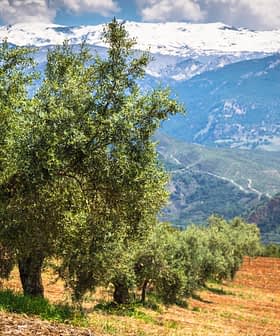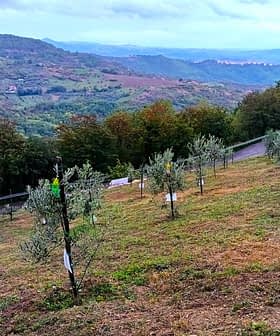Olives Left Unharvested in Tuscany

Changing market dynamics and reduced margins are leading to the abandonment of traditional olive orchards near Arezzo, Tuscany, with 40 percent of olives being left on trees due to a lack of workforce. Efforts are being made by cooperatives and institutions to restore abandoned orchards and prevent the loss of high-quality olive oil production in the region, which accounts for a significant portion of Italian olive oil sales.
Changing market dynamics and reduced margins are causing farmers to abandon traditional olive orchards near Arezzo, Tuscany, not far from Florence.
“Our landscape is suffering, as olive trees planted so long ago by our ancestors are often abandoned by the younger generations,” Giovan Battista Donati, president of the local olive oil miller association attached to the Confartigianato Association, told Olive Oil Times.
See Also:Restoring Abandoned Olive Trees at Leonardo da Vinci’s Home“The lack of workforce in the current season brought to at least 40 percent of the olives being left on the trees in our area,” he claimed.
According to Donati, the extraordinary quality of local olives is due to the unique soil those trees thrive on. “If you dig a hole here on the hills, half a meter below you will meet the stone. Here they grow, with just a little bit of water, those small-sized olives bear the traditional Tuscan flavors, just like it happens to vines grown on the hills,” Donati noted.
Immigrant workers and dedicated cooperatives comprise the most significant portion of Tuscany’s modern olive-related seasonal workforce. They tend to focus on the areas where the olive yield is seen as rewarding. “Today, if an olive orchard on the hills does not have many olives on the branches, nobody is going to harvest them,” Donati said.
Growers do not only have margins and costs challenges. “The often ubiquitous presence of the olive fruit fly, the climate alterations which are becoming increasingly frequent, the harvest season happening with high temperatures and the late spring frosts are all factors to which we need to adapt,” Donati underlined.
In a recent appeal to the local community and institutions, Donati highlighted how the area is at risk of losing its high-quality olive oil production tradition and culture. On top of that, he warned that abandoned olives might boost the fruit fly populations and that unguarded farmland might trigger further land management problems.
“Our olive trees grow on the rounded hills you can see while heading to Florence. The cypress trees, and the farmhouse on top of the hill, there are all the characteristics of the renowned Tuscan landscape. Such unique beauty has brought to the Made in Tuscany as a quality origin brand associated to olive oil production, wine, arts and landscape,” Donati noted.
The latest Italian data shows that Tuscan olive oil producers account for about seven percent of Italian olive oil production. EVOO-related sales bring a turnover of about €130 million. In Tuscany alone, 18 olive oil products scored a Gold Award at the latest New York International Olive Oil Competition, held in 2022.
“We should always remember that. The small olive oil production in Tuscany is so cherished around the world that it represents a large share of the Italian olive oil market,” Donati said.
“We witnessed such results because we used to have workforce in abundance; the olive farmer would produce his own olive oil and sell the rest. After working hours in a factory, many used to go back to the olive trees and close the day by pruning and managing their orchards. Now they are old and their sons do not harvest the olives anymore,” he added.
The experienced olive miller described the gulf that separates one generation from the other. “The high-quality farming DNA of the grandparents did not pass down to their nephews. Traditional orchards on the hills do not stand the market as modern mechanized orchards are planted in the Tuscan plains and obey to different market rules,” Donati noted.
“The phenomenon of the abandonment takes place in several areas in Tuscany, still many are working to reverse the olive orchards abandonment trend,” Tiziana Mariotti, agronomist at the Montalbano Wine and Olive Oil Milling Cooperative, told Olive Oil Times.
Thanks to national and regional funds, the cooperative has teamed up with local institutions and growers to restore abandoned orchards not far from Florence. “It is a truly challenging task, as the olive orchards’ extension is mostly very small and they are evenly scattered on the territory.”
As a whole, the cooperative has already restored production in five orchards and more than two thousand trees between the Vinci and Serravalle Pistoiese municipalities. In the same area, other cooperatives and initiatives are also trying to restore as many small abandoned orchards as possible.
Once they agree with the landowners, the cooperative restores the olive trees. “That often means to intervene in a vegetation which has almost completely hidden the olive trees among dozens of other species, with bushes growing all around them. After cleaning, you still have to manage olive trees, which might have grown up to 15 or even 20 meters,” Mariotti noted.
Once the olive orchard is restored, the cooperative and its olive oil mill will manage the crop for 10 years. “The best thing of such interventions is that they work as an example. Once you restore an orchard or make a cleaning intervention in one area, it happens quite often to see other growers in that same area do the same thing,” she explained.
Still, one of the main reasons the abandoned orchards continue to need restoration is correct land management. “That is why we also teamed up with agronomists and fire-prevention experts to focus on interventions that support territorial safety. One of the largest recent wildfires in Tuscany happened in an area close to a residential location, showing the urgency of such interventions,” she added.
See Also:Thousands of Olive Trees Destroyed by Wildfires in TuscanyAccording to Donati, “while olive growing becomes a hobby for people who are more and more concerned of costs and lower margins, the landscape is changing.”
“The hills are going to be abandoned by growers. That will bring our traditional, beautiful dry walls to collapse, precipitation and water will start excavating new routes predating nutrients and land from the hills and bringing them down to the plains,” Donati predicted.
In the Arezzo province, Donati estimated that of approximately 340 thousand residents, around 40 thousand own at least a few olive trees. “We can not go against our times, but there should be a strategic plan put in place to avoid to lose our hills and to keep olive oil production up to the highest standards,” Donati concluded.









